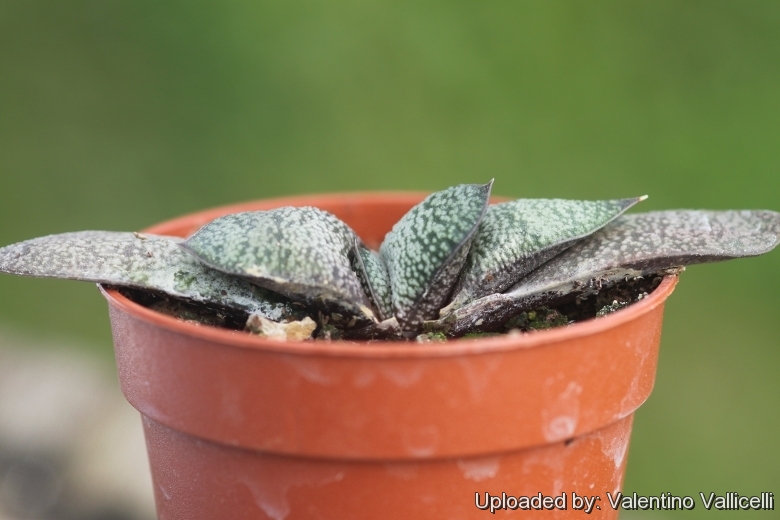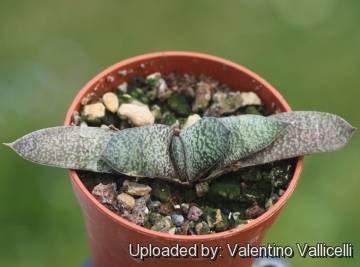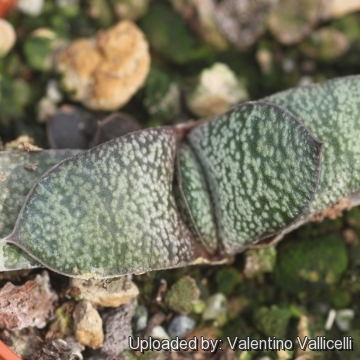




Your support is critical to our success.

Origin and Habitat: Kouga Dam (or Paul Sauer Dam) region, in eastern Cape Province, South Africa
Habitat: It is a cliff dweller that grows on shady, sheer rocky slopes. It grows together with Haworthia viscosaSN|15021]]SN|21283]] and Haworthia isabellaeSN|21283]]SN|15021]].
Synonyms:
- Gasteria ellaphieae van Jaarsv.
Description: Gasteria ellaphieaeSN|25212]]SN|25212]] is one of the most popular and sought species with propellers-shaped rough leaves.
Stem: Nearly stemless (acaulescent).
Roots: Cylindrical (terete), thick with little branching, and endowed with the ability to contract, physically pulling the plant down into the ground during dry weather.
Rosettes: Usually solitary up to 18 cm in diameter, leaves initially spreading in two opposite rows (distichous ) then beginning to spiral with age.
Leaves: When adult, this small plant has thick, rough-textured, triangular-lanceolate leaves. Both surfaces are dark-green taking on a reddish colour in strong light and mottled with dense white tubercles. The leaf apex is obtuse bearing a mucro.
Inflorescence: The inflorescence is slender branched raceme from which small stomach-shaped flowers dangle.
Flowers: Fluorescent red tubular with the lower part inflated (“gaster” from Greek, means “belly”) the base slightly swollen.
Blooming season: Late spring.

Gasteria ellaphieae Photo by: Valentino Vallicelli

Gasteria ellaphieae Photo by: Valentino Vallicelli
Cultivation and Propagation: Cultivation and Propagation: It is of easy culture and can grow on window sills, verandas and in miniature succulent gardens where it is happy to share its habitat with other smaller succulent plants, or in outdoor rockeries.
Growth rate: It is a relatively slow-growing plant that offsets to form in age small clusters.
Soil: It is tolerant of a wide range of soils and habitats, but prefers a very porous potting mix to increase drainage. You can grow a plant in a 10-15 cm pot for years and have perfectly happy plants. For best results, use a shallow pot.
Exposure: Need light shade to shade, but will take full sun part of the day. (with some sun exposure the leaf develops a nice reddish tint and remain compact)
Watering: During the hot summer months, the soil should be kept moist but not overly wet. During the winter months, water only when the soil becomes completely dry. Wet soil quickly causes root and stem rot, especially during chilly winter months. No water should ever be allowed to stand around the roots. Low ambient humidity is always needed.
Feeding: The plants are fertilized only once during the growing season with a balanced fertilizer diluted to ½ the recommended strength. Plants react well also to organic feeding (compost or any other liquid fertilizer).
Hardiness: During the winter months, water only when the soil becomes completely dry. Frost hardy to -1°C (Or less). It grows well in Mediterranean gardens where frost is not too severe.
Pest and diseases: Rot is only a minor problem with Gasteria if the plants are watered and “aired” correctly. If they are not, fungicides won't help all that much. Incorrect watering, poor drainage or too much shade can lead to attack by pests and diseases. Care must be given in watering, keeping them warm and wet while growing, and cooler and dry when dormant.
Remarks: Gasterias are best planted in a partially shaded and airy part of the greenhouse, and not too close to the glass roof or sides of the house as the plants can overheat during hot spells.
Propagation: Gasterias are easily propagated by the removal of offshoots or by leaf cuttings in spring or summer. To propagate by leaf cuttings, remove a leaf (best in spring) and let it lie for about one month, giving the wound time to heal. Then lay the leaf on its side with the basal part buried in the soil. This leaf should root within a month or two, and small plants will form at the leaf base. Cuttings are best rooted in clean sand. Once rooted, plants can be planted into individual containers. They can also grown from seed. Sow seed during spring or summer in a warm, shady position in a sandy, slightly acidic soil and keep moist. Cover with a thin layer of sand and keep moist. Germination is usually within 20 days. Seedlings grow slowly and are best planted out about a year after sowing. It is recommended to apply a fungicide when growing it from seed.
| Your Actions | |
|---|---|
| Back to Gasteria index | |
| Back to Aloaceae index | |
 |
Back to Succulents Encyclopedia index |
Privacy stantement - Terms and conditions - How to cite - About us - Feedback - Donate




